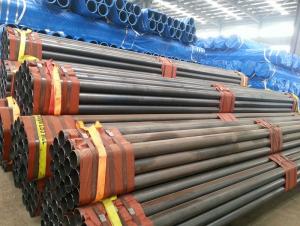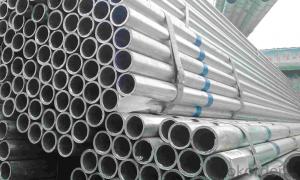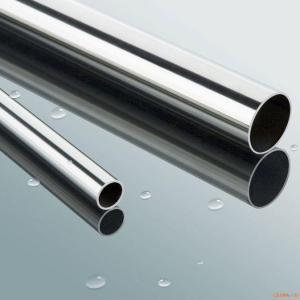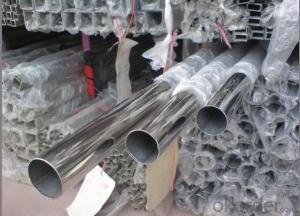STAINLESS STEEL FLOWER PIPES WITH WAVES
- Loading Port:
- China Main Port
- Payment Terms:
- TT OR LC
- Min Order Qty:
- -
- Supply Capability:
- -
OKorder Service Pledge
OKorder Financial Service
You Might Also Like
Description:
Stainless Steel Pipe
Material:
304 321 316 310
Packing:
In bundle
MOQ:
5 TONS
Comparison of standardized steels
| EN-standard Steel no. k.h.s DIN | EN-standard Steel name | SAE grade | UNS |
|---|---|---|---|
| 1.4109 | X65CrMo14 | 440A | S44002 |
| 1.4112 | X90CrMoV18 | 440B | S44003 |
| 1.4125 | X105CrMo17 | 440C | S44004 |
| | | 440F | S44020 |
| 1.4016 | X6Cr17 | 430 | S43000 |
| 1.4408 | G-X 6 CrNiMo 18-10 | 316 | |
| 1.4512 | X6CrTi12 | 409 | S40900 |
| | | 410 | S41000 |
| 1.4310 | X10CrNi18-8 | 301 | S30100 |
| 1.4318 | X2CrNiN18-7 | 301LN | |
| 1.4307 | X2CrNi18-9 | 304L | S30403 |
| 1.4306 | X2CrNi19-11 | 304L | S30403 |
| 1.4311 | X2CrNiN18-10 | 304LN | S30453 |
| 1.4301 | X5CrNi18-10 | 304 | S30400 |
| 1.4948 | X6CrNi18-11 | 304H | S30409 |
| 1.4303 | X5CrNi18-12 | 305 | S30500 |
| | X5CrNi30-9 | 312 | |
| 1.4541 | X6CrNiTi18-10 | 321 | S32100 |
| 1.4878 | X12CrNiTi18-9 | 321H | S32109 |
| 1.4404 | X2CrNiMo17-12-2 | 316L | S31603 |
| 1.4401 | X5CrNiMo17-12-2 | 316 | S31600 |
| 1.4406 | X2CrNiMoN17-12-2 | 316LN | S31653 |
| 1.4432 | X2CrNiMo17-12-3 | 316L | S31603 |
| 1.4435 | X2CrNiMo18-14-3 | 316L | S31603 |
| 1.4436 | X3CrNiMo17-13-3 | 316 | S31600 |
| 1.4571 | X6CrNiMoTi17-12-2 | 316Ti | S31635 |
| 1.4429 | X2CrNiMoN17-13-3 | 316LN | S31653 |
| 1.4438 | X2CrNiMo18-15-4 | 317L | S31703 |
| 1.4362 | X2CrNi23-4 | 2304 | S32304 |
| 1.4462 | X2CrNiMoN22-5-3 | 2205 | S31803/S32205 |
| 1.4539 | X1NiCrMoCu25-20-5 | 904L | N08904 |
| 1.4529 | X1NiCrMoCuN25-20-7 | | N08926 |
| 1.4547 | X1CrNiMoCuN20-18-7 | 254SMO | S31254 |
Stainless steel’s resistance to corrosion and staining, low maintenance and familiar lustre make it an ideal material for many applications. There are over 150 grades of stainless steel, of which fifteen are most commonly used. The alloy is milled into coils, sheets, plates, bars, wire, and tubing to be used in cookware, cutlery, household hardware, surgical instruments, major appliances, industrial equipment (for example, in sugar refineries) and as an automotive and aerospace structural alloy and construction material in large buildings. Storage tanks and tankers used to transport orange juice and other food are often made of stainless steel, because of its corrosion resistance. This also influences its use in commercial kitchens and food processing plants, as it can be steam-cleaned and sterilized and does not need paint or other surface finishes.
Stainless steel is used for jewelry and watches with 316L being the type commonly used for such applications. It can be re-finished by any jeweler and will not oxidize or turn black.
Some firearms incorporate stainless steel components as an alternative to blued or parkerized steel. Some handgun models, such as the Smith & Wesson Model 60 and the Colt M1911 pistol, can be made entirely from stainless steel. This gives a high-luster finish similar in appearance to nickel plating. Unlike plating, the finish is not subject to flaking, peeling, wear-off from rubbing (as when repeatedly removed from a holster), or rust when scratched.
- Q: Can stainless steel pipes be insulated with polyethylene-co-methacrylate?
- Polyethylene-co-methacrylate is not suitable for directly insulating stainless steel pipes due to various reasons. Firstly, stainless steel pipes can withstand high temperatures and maintain their structural integrity, whereas polyethylene-co-methacrylate may deform or deteriorate when exposed to heat. Secondly, stainless steel pipes require insulation with excellent corrosion resistance, which polyethylene-co-methacrylate may not provide against various chemicals or environmental factors. To ensure long-lasting and efficient insulation for stainless steel pipes, it is recommended to use insulation materials specifically designed for them, such as mineral wool, fiberglass, or polyurethane foam. These materials are known for their excellent thermal insulation properties and compatibility with stainless steel.
- Q: Can stainless steel pipes be used for both high and low-pressure applications?
- Yes, stainless steel pipes can be used for both high and low-pressure applications. Stainless steel pipes are known for their excellent strength, durability, and corrosion resistance, making them suitable for various pressure conditions. They are commonly used in industries such as oil and gas, chemical processing, and power generation, where both high and low-pressure applications are encountered.
- Q: Can stainless steel pipes be insulated with asbestos?
- Insulating stainless steel pipes with asbestos is not recommended due to its hazardous nature. Asbestos has been linked to severe health hazards, such as mesothelioma and lung cancer. The dangers of asbestos exposure are widely acknowledged, leading to its prohibition in numerous countries. Fortunately, there are numerous alternative insulation materials that are both safer and more effective than asbestos. These options include fiberglass, mineral wool, and foam insulation. These materials possess exceptional thermal insulation properties while eliminating the health risks associated with asbestos. When selecting an insulation material for stainless steel pipes, it is crucial to consider the specific requirements of the application and adhere to the necessary safety standards. Seeking guidance from a professional insulation contractor or engineer is always advisable to ensure the correct insulation material is chosen.
- Q: What are the different types of stainless steel pipe gaskets?
- There are several types of stainless steel pipe gaskets available, including ring gaskets, spiral wound gaskets, and sheet gaskets.
- Q: What is the difference between stainless steel pipes and carbon steel pipes?
- Stainless steel pipes and carbon steel pipes differ in their composition, properties, and applications. Composition: Stainless steel pipes are made primarily from an alloy of iron, chromium, and sometimes nickel. This composition gives stainless steel its corrosion-resistant properties. On the other hand, carbon steel pipes are made primarily from an alloy of iron and carbon. The carbon content in carbon steel pipes can range from 0.1% to 2.1%, which affects the strength and hardness of the material. Properties: Stainless steel pipes have excellent corrosion resistance, making them ideal for applications where the pipes will be exposed to moisture, chemicals, or other corrosive substances. They are also highly resistant to heat and can withstand high-pressure environments. Carbon steel pipes, on the other hand, are not as resistant to corrosion and are more susceptible to rust. However, they are stronger and more durable than stainless steel pipes, making them suitable for high-stress applications. Applications: Due to their corrosion resistance, stainless steel pipes are commonly used in industries such as food processing, pharmaceuticals, chemical processing, and marine applications. They are also widely used in plumbing, HVAC systems, and construction. Carbon steel pipes, with their higher strength and durability, are commonly used in oil and gas pipelines, structural applications, and machinery manufacturing. In summary, the main difference between stainless steel pipes and carbon steel pipes lies in their composition and properties. Stainless steel pipes are corrosion-resistant and heat-resistant, while carbon steel pipes are stronger and more durable. The choice between the two depends on the specific requirements of the application, such as the need for corrosion resistance, strength, or cost-effectiveness.
- Q: Can stainless steel pipes be coated with epoxy?
- Stainless steel pipes have the ability to be coated with epoxy, which is frequently utilized in a variety of industries to safeguard and enhance the performance of these pipes. By creating a protective barrier against corrosion, chemical damage, and abrasion, the epoxy coating effectively extends the pipes' lifespan. Moreover, it aids in enhancing the pipes' flow efficiency by minimizing friction and preventing the accumulation of deposits or scaling. Additionally, the application of epoxy coatings to stainless steel pipes allows for aesthetic purposes such as customization and color-coding of different pipe systems. In summary, the utilization of epoxy coatings on stainless steel pipes offers numerous advantages in terms of safeguarding, durability, and functionality.
- Q: What are the common standards for stainless steel pipes?
- Stainless steel pipes have varying common standards depending on the specific application and industry in which they are used. However, there are several widely recognized standards that are commonly employed in the manufacturing and specification of these pipes. One of the most extensively used standards is ASTM International, which is responsible for establishing standards for various materials, including stainless steel. ASTM A312/A312M serves as the standard specification for austenitic stainless steel pipes that are seamless, welded, and heavily cold worked. This comprehensive standard encompasses a wide range of pipe sizes and grades, including TP304, TP316, TP321, and more. Another standard frequently referenced is the American National Standards Institute (ANSI) standards. ANSI B36.19 specifically delineates the dimensions, tolerances, and materials for stainless steel pipes. This standard covers both seamless and welded stainless steel pipes, offering a multitude of sizes and schedules. Apart from these standards, there are also industry-specific standards. For instance, the American Petroleum Institute (API) has established standards like API 5L, which are specifically designed for line pipes used in the oil and gas industry. These standards outline the requirements for materials, dimensions, and testing of stainless steel pipes utilized in specific applications. Other standards organizations, including the International Organization for Standardization (ISO) and the European Committee for Standardization (EN), also contribute their own standards for stainless steel pipes. ISO 1127, for instance, specifies the dimensions and tolerances for stainless steel pipes used for general purposes. It is important to acknowledge that these standards are continuously updated and revised to align with technological advancements and industry requirements. Therefore, it is crucial to refer to the latest versions of these standards to ensure compliance and maintain the quality of stainless steel pipe manufacturing and usage.
- Q: Are stainless steel pipes suitable for underground sewage systems?
- Yes, stainless steel pipes are suitable for underground sewage systems. They have excellent corrosion resistance, durability, and strength, which make them highly reliable for handling sewage and wastewater in underground applications.
- Q: How do you prevent scaling in stainless steel pipes?
- Preventing scaling in stainless steel pipes can be achieved through various methods: 1. Regular maintenance and cleaning: Cleaning the stainless steel pipes on a regular basis is highly effective in preventing scaling. By utilizing suitable cleaning agents and techniques, any scale buildup or deposits can be removed. Inspecting the pipes frequently can also help identify signs of scaling early on, enabling immediate action. 2. Adequate water treatment: Scaling often occurs due to minerals and impurities present in the water. Employing an appropriate water treatment system can help eliminate or decrease these impurities, thus preventing scaling in stainless steel pipes. This may involve utilizing water softeners, filtration systems, or chemical treatments tailored to the specific water source requirements. 3. Temperature regulation: Controlling the temperature of the fluid flowing through the stainless steel pipes is crucial, as high temperatures can accelerate scaling. Maintaining the temperature within the recommended range helps minimize the formation of scale deposits. 4. Flow velocity management: Another factor contributing to scaling is the flow velocity of the fluid inside the pipes. Excessive flow velocities can cause turbulence, leading to increased scale formation. By adhering to the recommended limits for flow velocity, the risk of scaling can be minimized. 5. Consideration of material selection: The choice of stainless steel grade can impact the likelihood of scaling in certain cases. Some grades of stainless steel are more resistant to scaling than others. Seeking guidance from experts or professionals in the field can aid in selecting the appropriate stainless steel grade that is less prone to scaling. It is important to note that each situation may present unique factors to consider. Consulting professionals or specialists in the field is advisable to determine the most suitable preventive measures for specific applications.
- Q: What is the external insulation used for stainless steel pipes?
- Various materials like mineral wool, fiberglass, or foam are commonly utilized for the external insulation of stainless steel pipes. These insulating materials are applied to the outer surface of the pipes, serving the purpose of thermal insulation and safeguarding against heat loss or gain. By doing so, the insulation aids in sustaining the desired temperature of the fluid or substance flowing through the pipes, thereby preventing condensation and minimizing energy loss. Moreover, the external insulation acts as a barrier against corrosion and mechanical harm, guaranteeing the durability and effectiveness of the stainless steel pipes.
Send your message to us
STAINLESS STEEL FLOWER PIPES WITH WAVES
- Loading Port:
- China Main Port
- Payment Terms:
- TT OR LC
- Min Order Qty:
- -
- Supply Capability:
- -
OKorder Service Pledge
OKorder Financial Service
Similar products
Hot products
Hot Searches
Related keywords


























